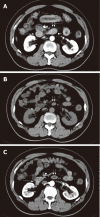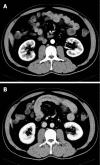Transient small bowel angioedema due to intravenous iodinated contrast media
- PMID: 22408362
- PMCID: PMC3297062
- DOI: 10.3748/wjg.v18.i9.999
Transient small bowel angioedema due to intravenous iodinated contrast media
Abstract
Three cases of transient proximal small bowel angioedema induced by intravenous administration of nonionic iodinated contrast media (CM) are presented. Computed tomography (CT) images in the venous phase displayed the proximal small bowel with circumferential thickening of the wall including the duodenum and proximal segment of the jejunum. The bowel wall was normal in non-enhanced images, and normal or inconspicuous in arterial phase enhanced images. In one of the three cases, the bowel wall was thickened in venous phase but disappeared in the 40 s delayed phase images. No filling defect was seen in the lumen of the superior mesenteric artery and vein. No peritoneal effusion or mesentery abnormality was found. Each of these patients reported only mild abdominal discomfort and recovered without specific treatment within a short time. Only one patient suffered mild diarrhea after scanning which had resolved by the following day. The transient anaphylactic small bowel angioedema due to intravenous iodinated contrast media was easily diagnosed based on its characteristic CT findings and clinical symptoms. Differential diagnosis may include inflammatory and ischemic bowel disease, as well as neoplasms. A three-phase CT protocol and good understanding of this disorder are fundamentally important in the diagnosis of this condition. The supposed etiology behind the transient anaphylactic reaction to intravenous administration of iodinated CM in small bowel is similar to other CM-induced hypersensitive immediate reactions. The predilection location of transient anaphylactic bowel angioedema is the small intestine, particularly the proximal segment. A speculated cause may be the richer supply of vessels in the small intestine, ample mucous folds and loose connective tissue in the duodenum and the jejunum.
Keywords: Bowel angioedema; Bowel thickening; Computed tomography; Contrast media; Small bowel anaphylaxis.
Figures



References
-
- Wang CL, Cohan RH, Ellis JH, Caoili EM, Wang G, Francis IR. Frequency, outcome, and appropriateness of treatment of nonionic iodinated contrast media reactions. Am J Roentgenol. 2008;191:409–415. - PubMed
-
- Mortelé KJ, Oliva MR, Ondategui S, Ros PR, Silverman SG. Universal use of nonionic iodinated contrast medium for CT: evaluation of safety in a large urban teaching hospital. Am J Roentgenol. 2005;184:31–34. - PubMed
-
- Polger M, Kuhlman JE, Hansen FC 3rd, Fishman EK. Computed tomography of angioedema of small bowel due to reaction to radiographic contrast medium. J Comput Assist Tomogr. 1998;12:1044–1046. - PubMed
-
- Kim SH, Cho JY, Lim HK. CT findings of isolated small bowel angioedema due to iodinated radiographic contrast medium reaction. Abdom Imaging. 1999;24:117–119. - PubMed
-
- Blake SP, McNicholas MM. Hypersensitivity to intravenous contrast material causing CT appearance of bowel wall thickening. Clin Radiol. 2004;59:638–640. - PubMed
Publication types
MeSH terms
Substances
LinkOut - more resources
Full Text Sources

